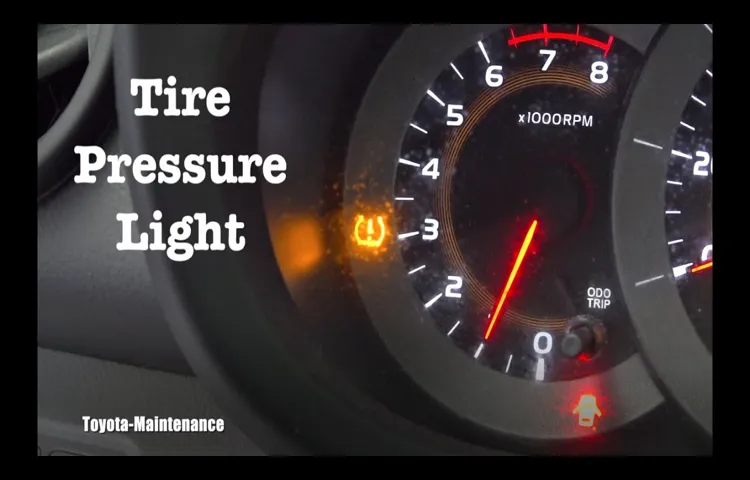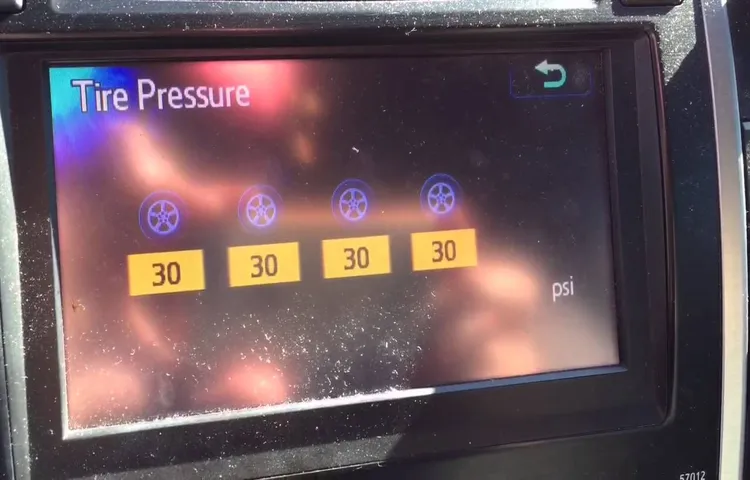Have you ever wondered whether your Toyota Camry’s tire pressure is optimal? Checking tire pressure is essential for maintaining vehicle safety and ensuring that your car performs at its best. Toyota Camry is a popular car model and checking its tire pressure is a necessary part of car maintenance. Low tire pressure can result in reduced gas mileage and increased wear and tear on the tires.
Besides, over-inflated tires can lead to a bumpy ride and uncomfortable driving experience. As a Camry owner, you may wonder how to check the tire pressure yourself. Don’t worry, it’s easy and straightforward.
In this blog, we’ll guide you through the steps to check the tire pressure on your Toyota Camry. Not only will you learn how to check the tire pressure, but you’ll also gain a better understanding of why it’s important and how to maintain optimal tire pressure for your Toyota Camry. Let’s dive into the post, and you’ll be a pro at checking your Toyota Camry’s tire pressure by the end.
Table of Contents
- 1 Why Checking Tire Pressure is Important
- 2 What You’ll Need to Check Tire Pressure
- 3 Steps to Check Tire Pressure
- 3.1 Step 1: Check Recommended Tire Pressure
- 3.2 Step 2: Park Camry on a Level Surface
- 3.3 Step 3: Remove Tire Valve Caps
- 3.4 Step 4: Attach Tire pressure Gauge to Valve Stem
- 3.5 Step 5: Read Tire Pressure on Gauge
- 3.6 Step 6: Inflate or Deflate Tires as Needed
- 3.7 Step 7: Replace Valve Caps and Recap Tire Pressue Gauge
- 4 Conclusion
- 5 FAQs
Why Checking Tire Pressure is Important
If you own a Toyota Camry, it’s crucial to keep an eye on your tire pressure. Checking your tire pressure regularly can help prolong the life of your tires, improve fuel economy, and ensure your car handles properly on the road. To check your tire pressure, you’ll need a tire pressure gauge and access to an air compressor or gas station.
Simply remove the valve cap, press the gauge onto the valve stem, and take a reading. If the pressure is too low, add air until it reaches the recommended PSI listed in your owner’s manual. If it’s too high, release air until it’s at the correct pressure.
Be sure to check all four tires, including your spare, and make adjustments as needed. By taking a few minutes to check your tire pressure, you’ll be doing yourself and your Toyota Camry a favor!
Safety: Keeping You and Your Passengers Safe
If you’re thinking that checking tire pressure is just an unnecessary expense or additional workload, think again. Maintaining proper tire pressure is one of the most crucial safety measures that you should always keep in mind. It’s a simple task that can go a long way in preventing disasters on the road.
Driving with underinflated tires can lead to poor handling, decreased fuel efficiency, and even blowouts. On the other hand, overinflated tires can cause sudden impact and damage to your car’s suspension system. A car’s tire pressure can change depending on the temperature, so it’s important to check them regularly, ideally once a month.
Make sure to use a tire pressure gauge to get accurate readings. Trust me; checking your tire pressure regularly will give you peace of mind and save you a lot of headaches in the long run. So, don’t forget to check and inflate to the recommended levels.

Improved Fuel Efficiency
Improved fuel efficiency is something that every driver desires, and checking tire pressure is an important part of achieving it. When your tires are not properly inflated, it can cause your vehicle to use more fuel than it should. In fact, studies have shown that under-inflated tires can reduce fuel efficiency by up to 3%.
This may not seem like a significant amount, but it can add up over time. By checking your tire pressure regularly, you can ensure that your tires are at the optimal level, which can help to improve fuel efficiency. Plus, properly inflated tires last longer, which means you’ll save money in the long run.
So, the next time you hit the road, take a few minutes to check your tire pressure. Your wallet (and the environment) will thank you!
Extended Tire Life
As a vehicle owner, checking tire pressure is crucial for a variety of reasons. Not only does it ensure your safety on the road, but it can also lead to extended tire life. When tires are underinflated, they tend to wear out faster and unevenly.
This happens because the tire isn’t able to distribute the weight of the vehicle evenly across the surface of the tire. However, overinflated tires can also be problematic, leading to a harsh ride and damage to the tire. By keeping your tires inflated to the recommended pressure, you can ensure that they wear evenly and last longer.
It’s important to check tire pressure regularly, at least once a month, to maintain optimal inflation levels. By doing so, you not only prolong the life of your tires but also improve fuel efficiency and save money on the cost of replacing tires. So, next time you’re on the road, ask yourself, “When was the last time I checked my tire pressure?” It could make all the difference in the long run.
Preserving Vehicle Performance
If you’re wondering why checking tire pressure is important, there are actually several reasons to consider. First and foremost, maintaining the proper tire pressure can go a long way in preserving your vehicle’s overall performance. Underinflated or overinflated tires can cause uneven wear and tear, which can negatively impact your vehicle’s handling and fuel efficiency.
Additionally, driving on tires that are either too low or too high in pressure can also increase the risk of a blowout or other tire-related accidents. It’s also worth noting that tire pressure can change with temperature fluctuations, so it’s a good idea to periodically check your tires to ensure they’re inflated to the manufacturer’s recommended specifications. By making tire pressure checks a regular part of your vehicle maintenance routine, you can help prolong the lifespan of your tires and maximize your driving experience in the long run.
What You’ll Need to Check Tire Pressure
If you own a Toyota Camry, it’s important to keep an eye on your tire pressure to ensure a safe and smooth ride. To check your tire pressure, you’ll need a tire pressure gauge, which can be found at most auto parts stores. Make sure to check your tire pressure when your tires are cold – meaning, they haven’t been driven on for at least three hours.
Once you have your tire pressure gauge, unscrew the cap on your tire valve and place the gauge over the valve. You’ll hear a hissing sound as you press down on the gauge, and a measurement will appear on the gauge’s screen. Make sure to compare this measurement to the recommended tire pressure for your specific Toyota Camry model, which can be found in your owner’s manual or on a sticker inside the driver’s side door jamb.
If your tire pressure is below the recommended amount, add air using a tire inflator. Keeping your tires properly inflated is not only important for safety, but it can also improve your gas mileage and prolong the life of your tires.
Tire pressure gauge
To check tire pressure accurately, you’ll need a tire pressure gauge. This handy tool is a small device that fits onto the valve stem of your tire and reads the pressure inside. Tire pressure gauges come in various types, including digital, analog, and stick-style gauges.
Digital gauges are the most accurate and the easiest to read. Analog gauges require a bit of experience to use correctly, but they are still very reliable. Stick-style gauges are the least accurate, but they are affordable and easy to use.
No matter which type of gauge you choose, make sure it is calibrated correctly before using it to check your tire pressure. By having a tire pressure gauge readily available, you can ensure that your tires maintain the correct pressure, improving vehicle handling and extending your tires’ lifespan.
Toyota Camry owner’s manual
As a Toyota Camry owner, it’s essential to check your tire pressure regularly. To do so, you’ll need a tire pressure gauge and access to an air compressor or tire inflator. The ideal tire pressure for your vehicle can be found in the owner’s manual or on the driver’s side door jamb.
Once you know the appropriate pressure, remove the valve cap from each tire and insert the gauge into the valve stem. The gauge will provide a reading for the current tire pressure. If the pressure is too low, use the air compressor or tire inflator to add air until reaching the recommended level.
If the pressure is too high, release air by pressing the pin at the center of the valve stem with a small tool. It’s important to check tire pressure monthly and before long trips to ensure proper handling and fuel efficiency. By maintaining proper tire pressure, you’ll also extend the life of your tires and improve overall safety on the road.
Small notepad and pen (optional)
When it comes to maintaining your vehicle’s health, checking tire pressure is an essential aspect that cannot be ignored. To ensure the optimal performance of your car’s tires, you’ll need a few things to help you check the pressure accurately. Firstly, you’ll need a reliable tire pressure gauge that measures PSI (pounds per square inch).
Secondly, you’ll need a source of compressed air to refill your tires if needed. Additionally, it’s recommended to have a small notepad and pen to record the pressure readings for future reference. Although not mandatory, this could come in handy when comparing readings over time or tracking a tire’s slow leak.
With these tools at hand, you can easily check your vehicle’s tire pressure regularly, which will lead to smoother and safer driving experiences. So, invest in the right tools today and make tire pressure checks a regular part of your car maintenance routine.
Steps to Check Tire Pressure
If you own a Toyota Camry, checking your tire pressure is essential to ensure a smooth and safe ride. Here are some simple steps to help you check your tire pressure on a Toyota Camry. Firstly, ensure that your tires are cold before starting.
Next, locate the tire pressure label, which can be found on the driver’s side door jamb or in the owner’s manual. Refer to this label and use a tire pressure gauge to measure the pressure in each tire, starting at the front-left tire, then moving clockwise around the vehicle. If the pressure is below the recommended level, inflate the tire to the correct pressure using an air compressor or gas station air pump.
Repeat this process for each tire and ensure that the pressure is uniform across all tires. Proper tire pressure helps to improve fuel efficiency, extend the life of your tires, and ensure your safety on the road. It’s an easy task that you can do regularly to ensure your Toyota Camry performs at its best.
Step 1: Check Recommended Tire Pressure
Tire Pressure One of the most important steps in maintaining your vehicle’s tires is checking the recommended tire pressure. It’s easy to overlook tire pressure, but it can have a significant impact on your car’s performance and safety. Before checking the tire pressure, ensure that the tires are cool and that you have a tire pressure gauge.
The recommended tire pressure can be found in the owner’s manual or on a placard located on the driver’s door or doorjamb. The recommended tire pressure varies depending on the vehicle, tire size, and load capacity. It’s crucial to follow the recommended tire pressure to ensure maximum performance, fuel efficiency, and safety.
Overinflated or underinflated tires can lead to premature wear, decreased fuel economy, decreased traction, and potential blowouts. By checking and maintaining the recommended tire pressure, you’ll extend the life of your tires, save money on fuel expenses, and improve your vehicle’s handling and safety.
Step 2: Park Camry on a Level Surface
Checking your car’s tire pressure regularly is important for maintaining optimal performance and safety on the road. However, before you start checking tire pressure, you need to park your car on a level surface. This ensures that the tires are properly aligned and balanced.
Parking on uneven surfaces can give you inaccurate readings on your tire pressure, which could lead to underinflation or overinflation. Once you have parked your Toyota Camry on a level surface, turn off the engine and engage the parking brake. Check your owner’s manual or the sticker inside the driver’s side door to find the recommended tire pressure for your vehicle.
This will be expressed in PSI or pounds per square inch. Take a tire pressure gauge and attach it to the valve stem of your tire, pressing down firmly to get an accurate reading. Repeat this process for all four tires and ensure that they are within the recommended range.
Keeping your tires at the recommended pressure level not only improves your car’s handling but also results in increased fuel efficiency and prevents premature wear and tear of your tires.
Step 3: Remove Tire Valve Caps
When it comes to maintaining your vehicle, checking your tire pressure is an essential step that should not be overlooked. In order to accurately check your tire pressure, it’s important to remove the valve caps from each tire. These small caps protect the tire valve from dirt and debris but can impede your ability to check the tire pressure.
Removing the caps is a simple process, but it’s important to keep them somewhere safe so they can be easily replaced once you’ve finished. Many tire pressure gauges have a built-in tool for removing valve caps, but a small pair of pliers can also do the trick. Once the caps are removed, you can move onto the next step of checking your tire pressure and ensuring your vehicle is operating safely and efficiently.
Remember, regularly checking your tire pressure is an important part of vehicle maintenance that can prevent accidents and save you money in the long run.
Step 4: Attach Tire pressure Gauge to Valve Stem
After locating the valve stem on your vehicle’s tires, the next step is to attach the tire pressure gauge. This tool is crucial for measuring the air pressure in your tires accurately. To use it, simply place the nozzle of the gauge onto the valve stem and press down firmly.
This will create a seal between the gauge and the stem, which ensures an accurate reading. If you hear air escaping while attaching the gauge, adjust the nozzle or valve stem until it fits snugly without any air leakage. Once the gauge is securely attached, you can check the reading and compare it to the recommended pressure levels for your vehicle.
It’s essential to do this regularly to maintain proper tire inflation and extend the life of your tires while improving fuel efficiency. So, don’t forget to attach the tire pressure gauge properly and keep your tires in top-notch condition.
Step 5: Read Tire Pressure on Gauge
After attaching the tire gauge to the valve stem, the next step is to read the tire pressure on the gauge. The gauge will display the tire pressure in pounds per square inch (PSI). The recommended PSI for your tires can be found in your vehicle’s owner manual or in the sticker located on the driver’s side door jamb.
If the reading on the gauge falls within the recommended range, then your tire pressure is adequate. However, if the reading is too low or too high, you need to adjust the tire pressure accordingly. Remember that underinflated tires wear out faster and reduce fuel economy, while overinflated tires provide less traction and can cause handling issues.
Therefore, it’s important to maintain proper tire pressure for safety, fuel efficiency, and tire longevity. Regularly checking your tire pressure will also help you detect leaks or punctures before they turn into bigger problems. Overall, reading the tire pressure on the gauge is a simple task that can go a long way in ensuring your tires are up to par and your vehicle drives smoothly.
Step 6: Inflate or Deflate Tires as Needed
When it comes to ensuring your vehicle’s safety and performance, checking tire pressure is an essential task. One of the final steps in this process is to inflate or deflate your tires as needed. Overinflated tires can cause excessive wear on the center of the tread, while underinflated tires can lead to poor fuel economy and unstable driving conditions.
It’s crucial to refer to your vehicle’s recommended tire pressure, which can typically be found on a sticker inside the driver’s side door, and use a tire pressure gauge to make accurate adjustments. Don’t forget to also check and adjust the spare tire if needed. By taking the time to properly inflate or deflate your tires, you can prolong their lifespan and enjoy a safer and smoother ride.
Remember, consistently checking tire pressure is an easy and cost-effective way to keep your vehicle in top shape.
Step 7: Replace Valve Caps and Recap Tire Pressue Gauge
When checking your car’s tire pressure, it’s important not to overlook the small details, such as replacing valve caps and recap tire pressure gauges. These little pieces may seem insignificant, but they play an important role in maintaining the proper air pressure in your tires. Valve caps protect the valve stem from dirt and debris, while also helping to maintain tire pressure by preventing air from escaping.
Meanwhile, the tire pressure gauge cap helps to keep dust and other particles out of the gauge, ensuring accurate readings. By replacing these small components after checking your tire pressure, you can help extend the life and performance of your tires and ensure your safety on the road. So, take the extra minute or two to replace valve caps and recap tire pressure gauges after checking your tire pressure, and you’ll be sure to reap the benefits in the long run.
Conclusion
In conclusion, checking the tire pressure on your Toyota Camry is a quick and easy task that can save you money on gas and extend the life of your tires. Plus, you’ll have the satisfaction of knowing that you’re driving on properly inflated tires and keeping yourself and others on the road safe. So don’t be a flat-tire-ulent driver, take the time to check your tire pressure regularly and enjoy a smooth and efficient ride!”
Checking tire pressure is a vital vehicle maintenance task and the steps to check the tire pressure on your Camry are simple and straightforward. By properly inflating your tires, you will help ensure the safety of you and your passengers, improve fuel efficiency and extend tire life.
Checking tire pressure is a crucial part of vehicle maintenance that is often overlooked. Properly inflating your tires can improve safety, fuel efficiency, and tire life. Fortunately, checking the tire pressure on your Toyota Camry is a simple and straightforward task.
First, locate the tire pressure gauge in your Camry’s glove compartment or purchase a separate tire pressure gauge at a local auto supply store. Then, remove the valve cap from the tire and press the gauge onto the valve stem. The gauge will display the tire pressure in PSI, and you can compare it to the recommended levels listed in your Camry’s owner’s manual or on a sticker on the driver’s side door jamb.
If the tire pressure is low, use an air compressor to inflate the tire to the recommended level. Remember to check the pressure in all four tires, including the spare, every month and before long road trips. By taking the time to check your tire pressure, you can help ensure a safe and comfortable driving experience for you and your passengers.
FAQs
Why is it important to check tire pressure on a Toyota Camry?
Checking tire pressure helps improve fuel efficiency, tire lifespan, and vehicle safety.
What tools are needed to check tire pressure on a Toyota Camry?
You will need a tire pressure gauge and an air compressor or tire inflator.
How often should tire pressure be checked on a Toyota Camry?
It is recommended to check tire pressure at least once a month or before long trips.
How do you know the correct tire pressure for a Toyota Camry?
The recommended tire pressure can be found in the owner’s manual or on a label on the driver-side door jamb.
Can tire pressure affect the handling and performance of a Toyota Camry?
Yes, low or high tire pressure can affect the handling, braking, and fuel consumption of the vehicle.
Is it safe to drive a Toyota Camry with low tire pressure?
No, driving with low tire pressure can cause tire damage, poor handling, and the risk of a tire blowout.
How do you properly inflate tires on a Toyota Camry?
Use the recommended tire pressure, check the pressure with a gauge, and inflate the tires evenly. Repeat until the correct pressure is reached.



